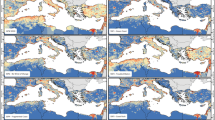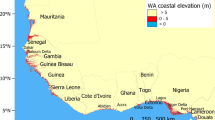Abstract
Large-area coastal exposure and impact analysis has focussed on using sea-level rise (SLR) scenarios and has placed little emphasis on socioeconomic scenarios, while neglecting spatial variations of population dynamics. We use the Dynamic Interactive Vulnerability Assessment (DIVA) Framework to assess the population exposed to 1 in 100-year coastal flood events under different population scenarios, that are consistent with the shared socioeconomic pathways (SSPs); and different SLR scenarios, derived from the representative concentration pathways (RCPs); and analyse the effect of accounting for regionalised population dynamics on population exposure until 2100. In a reference approach, we use homogeneous population growth on national level. In the regionalisation approaches, we test existing spatially explicit projections that also account for urbanisation, coastal migration and urban sprawl. Our results show that projected global exposure in 2100 ranges from 100 million to 260 million, depending on the combination of SLR and population scenarios and method used for regionalising the population projections. The assessed exposure based on the regionalised approaches is higher than that derived from the reference approach by up to 60 million people (39%). Accounting for urbanisation and coastal migration leads to an increase in exposure, whereas considering urban sprawl leads to lower exposure. Differences between the reference and the regionalised approaches increase with higher SLR. The regionalised approaches show highest exposure under SSP5 over most of the twenty-first century, although total population in SSP5 is the second lowest overall. All methods project the largest absolute growth in exposure for Asia and relative growth for Africa.



Similar content being viewed by others
References
Arnell NW, Livermore M, Kovats S, Levy PE, Nicholls R, Parry ML, Gaffin SR (2004) Climate and socio-economic scenarios for global-scale climate change impacts assessments: Characterising the SRES storylines. Glob Environ Chang 14(1):3–20
Arns A, Dangendorf S, Jensen J, Talke S, Bender J, Pattiaratchi C (2017) Sea-level rise induced amplification of coastal protection design heights. Sci Rep 7:40171
Balk DL, Deichmann U, Yetman G, Pozzi F, Hay SI, Nelson A (2006) Determining global population distribution: methods, applications and data. In: Meltzer MI (ed) Global mapping of infectious diseases: methods, examples and emerging applications, vol 62. Advances in parasitology. Elsevier, Amsterdam, pp 119–156
Brown S, Nicholls RJ, Woodroffe CD, Hanson S, Hinkel J, Kebede AS, Neumann B, Vafeidis AT (2013) Sea-level rise impacts and responses: a global perspective. In: Finkl CW (ed) Coastal Hazards, vol 1000. Coastal Research Library. Springer Netherlands, Dordrecht, pp 117–149
Church JA, Clark PU, Cazenave A, Gregory JM, Jevrejeva S, Levermann A, Merrifield MA, Milne GA, Nerem RS, Nunn PD, Payne AJ, Pfeffer WT, Stammer D, Unnikrishnan AS (2013) Sea level change. In: Stocker TF, Qin D, Plattner G-K, Tignor M, Allen S, Boschung J, Nauels A, Xia Y, Bex V, Midgley P (eds) Climate change 2013: the physical science basis: contribution of working group I to the fifth assessment report of the intergovernmental panel on climate change. Cambridge University Press, Cambridge, pp 1137–1216
CIESIN (Center for International Earth Science Information Network - Columbia University), IFPRI (International Food Policy Research Institute), (The World Bank), CIAT (Centro Internacional de Agricultura Tropical) (2011a) Global Rural-Urban Mapping Project, Version 1 (GRUMPv1): Population Count Grid. NASA Socioeconomic Data and Applications Center (SEDAC), Palisades, NY
CIESIN (Center for International Earth Science Information Network - Columbia University), IFPRI (International Food Policy Research Institute), (The World Bank), CIAT (Centro Internacional de Agricultura Tropical) (2011b) Global Rural-Urban Mapping Project, Version 1 (GRUMPv1): Urban Extents Grid. NASA Socioeconomic Data and Applications Center (SEDAC), Palisades, NY
Engström K, Olin S, Rounsevell MDA, Brogaard S, van Vuuren DP, Alexander P, Murray-Rust D, Arneth A (2016) Assessing uncertainties in global cropland futures using a conditional probabilistic modelling framework. Earth Syst Dynam 7(4):893–915
Gaffin SR, Rosenzweig C, Xing X, Yetman G (2004) Downscaling and geo-spatial gridding of socio-economic projections from the IPCC special report on emissions scenarios (SRES). Glob Environ Chang 14(2):105–123
Gao J (2017) Downscaling global spatial projections from 1/8-degree to 1-km grid cells. NCAR Technical Note NCAR/TN-537+STR
Grübler A, O'Neill B, Riahi K, Chirkov V, Goujon A, Kolp P, Prommer I, Scherbov S, Slentoe E (2007) Regional, national, and spatially explicit scenarios of demographic and economic change based on SRES. Technol Forecast Soc Chang 74(7):980–1029
Hallegatte S, Green C, Nicholls RJ, Corfee-Morlot J (2013) Future flood losses in major coastal cities. Nat Clim Chang 3(9):802–806
Hanson S, Nicholls R, Ranger N, Hallegatte S, Corfee-Morlot J, Herweijer C, Chateau J (2011) A global ranking of port cities with high exposure to climate extremes. Clim Chang 104(1):89–111
Hinkel J, Brown S, Exner L, Nicholls RJ, Vafeidis AT, Kebede AS (2012) Sea-level rise impacts on Africa and the effects of mitigation and adaptation: an application of DIVA. Reg Environ Chang 12(1):207–224
Hinkel J, Lincke D, Vafeidis AT, Perrette M, Nicholls RJ, Tol RSJ, Marzeion B, Fettweis X, Ionescu C, Levermann A (2014) Coastal flood damage and adaptation costs under 21st century sea-level rise. Proc Natl Acad Sci U S A 111(9):3292–3297
Hinkel J, Nicholls RJ, Tol RS, Wang ZB, Hamilton JM, Boot G, Vafeidis AT, McFadden L, Ganopolski A, Klein RJ (2013) A global analysis of erosion of sandy beaches and sea-level rise: an application of DIVA. Glob Planet Chang 111:150–158
Hinkel J, Nicholls RJ, Vafeidis AT, Tol RS, Avagianou T (2010) Assessing risk of and adaptation to sea-level rise in the European Union: an application of DIVA. Mitig Adapt Strateg Glob Change 15(7):703–719
Hoornweg D, Pope K (2016) Population predictions for the world’s largest cities in the 21st century. Environ Urban
Jarvis A, Reuter HI, Nelson A, Guevara E (2008) Hole-filled SRTM for the globe Version 4: Available from the CGIAR-CSI SRTM 90m Database. http://srtm.csi.cgiar.org
Jiang L, O’Neill BC (2017) Global urbanization projections for the shared socioeconomic pathways. Glob Environ Chang 42:193–199
Jones B, O’Neill BC (2016) Spatially explicit global population scenarios consistent with the shared socioeconomic pathways. Environ Res Lett 11(8):84003
Jongman B, Ward PJ, Aerts JC (2012) Global exposure to river and coastal flooding: long term trends and changes. Glob Environ Chang 22(4):823–835
KC S, Lutz W (2017) The human core of the shared socioeconomic pathways: population scenarios by age, sex and level of education for all countries to 2100. Glob Environ Chang 42:181–192
Kummu M, de Moel H, Salvucci G, Viviroli D, Ward PJ, Varis O (2016) Over the hills and further away from coast: global geospatial patterns of human and environment over the 20th–21st centuries. Environ Res Lett 11(3):34010
Lichter M, Vafeidis AT, Nicholls RJ, Kaiser G (2011) Exploring data-related uncertainties in analyses of land area and population in the “low-elevation coastal zone” (LECZ). J Coast Res 274:757–768
McGranahan G, Balk D, Anderson B (2007) The rising tide: assessing the risks of climate change and human settlements in low elevation coastal zones. Environ Urban 19(1):17–37
Merkens J-L, Reimann L, Hinkel J, Vafeidis AT (2016) Gridded population projections for the coastal zone under the shared socioeconomic pathways. Glob Planet Chang 145:57–66
Merkens J-L, Vafeidis A (2018) Using information on settlement patterns to improve the spatial distribution of population in coastal impact assessments. Sustainability 10(9):3170
Mondal P, Tatem AJ (2012) Uncertainties in measuring populations potentially impacted by sea level rise and coastal flooding. PLoS One 7(10):e48191
Muis S, Verlaan M, Winsemius HC, Aerts JCJH, Ward PJ (2016) A global reanalysis of storm surges and extreme sea levels. Nat Commun 7:11969
Muis S, Verlaan M, Nicholls RJ, Brown S, Hinkel J, Lincke D, Vafeidis AT, Scussolini P, Winsemius HC, Ward PJ (2017) A comparison of two global datasets of extreme sea levels and resulting flood exposure. Earth's Future 5(4):379–392
Neumann B, Vafeidis AT, Zimmermann J, Nicholls RJ (2015) Future coastal population growth and exposure to sea-level rise and coastal flooding--a global assessment. PLoS One 10(3):e0118571
Nicholls RJ (2004) Coastal flooding and wetland loss in the 21st century: changes under the SRES climate and socio-economic scenarios. Glob Environ Chang 14(1):69–86
Nicholls RJ, Mimura N (1998) Regional issues raised by sea-level rise and their policy implications. Clim Res 11:5–18
Nicholls RJ, Wong PP, Burkett V, Woodroffe CD, Hay J (2008) Climate change and coastal vulnerability assessment: scenarios for integrated assessment. Sustain Sci 3(1):89–102
O’Neill BC, Kriegler E, Ebi KL, Kemp-Benedict E, Riahi K, Rothman DS, Ruijven v, van Vuuren DP, Birkmann J, Kok K, Levy M, Solecki W (2017) The roads ahead: narratives for shared socioeconomic pathways describing world futures in the 21st century. Glob Environ Chang 42:169–180
Poulter B, Halpin PN (2008) Raster modelling of coastal flooding from sea-level rise. Int J Geogr Inf Sci 22(2):167–182
Prather M, Flato G, Friedlingstein P, Jones C, Lamarque J-F, Liao H, Rasch P (2014) Annex II: climate system scenario tables. In: Stocker TF, Qin D, Plattner G-K, Tignor M, Allen S, Boschung J, Nauels A, Xia Y, Bex V, Midgley P (eds) Climate change 2013: the physical science basis: contribution of working group I to the fifth assessment report of the intergovernmental panel on climate change. Cambridge University Press, Cambridge
Seto KC (2011) Exploring the dynamics of migration to mega-delta cities in Asia and Africa: contemporary drivers and future scenarios. Glob Environ Chang 21:S94–S107
Spencer T, Schuerch M, Nicholls RJ, Hinkel J, Lincke D, Vafeidis AT, Reef R, McFadden L, Brown S (2016) Global coastal wetland change under sea-level rise and related stresses: the DIVA wetland change model. Glob Planet Chang 139:15–30
UN (United Nations, Department of Economic and Social Affairs, Population Division) (2015) World urbanization prospects: the 2014 revision. United Nations, New York
USGS (United States Geological Survey) (1996) Global digital elevation model: GTOPO30. http://earthexplorer.usgs.gov/
van Vuuren DP, Kriegler E, O’Neill BC, Ebi KL, Riahi K, Carter TR, Edmonds J, Hallegatte S, Kram T, Mathur R, Winkler H (2014) A new scenario framework for climate change research: scenario matrix architecture. Clim Chang 122(3):373–386
Vousdoukas MI, Voukouvalas E, Mentaschi L, Dottori F, Giardino A, Bouziotas D, Bianchi A, Salamon P, Feyen L (2016) Developments in large-scale coastal flood hazard mapping. Nat Hazards Earth Syst Sci 16(8):1841–1853
Acknowledgments
The authors would like to express their thanks to the editor and the reviewers for their valuable comments. We would also like to thank Maureen Tsakiris for illustrating Fig. 1.
Author information
Authors and Affiliations
Corresponding author
Additional information
Publisher’s Note
Springer Nature remains neutral with regard to jurisdictional claims in published maps and institutional affiliations.
Electronic supplementary material
ESM 1
(DOCX 4644 kb)
Rights and permissions
About this article
Cite this article
Merkens, JL., Lincke, D., Hinkel, J. et al. Regionalisation of population growth projections in coastal exposure analysis. Climatic Change 151, 413–426 (2018). https://doi.org/10.1007/s10584-018-2334-8
Received:
Accepted:
Published:
Issue Date:
DOI: https://doi.org/10.1007/s10584-018-2334-8




